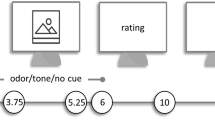Abstract
Background
We investigated the effects of worrying information about chemical pollution on subjective symptoms in response to an odor that was previously associated with symptom episodes.
Methods
Ammonia and butyric acid in harmless concentrations were used as odor cues, and 10% CO2-enriched air was used to induce symptoms. One of two odors was consistently mixed with CO2-enriched air while the other odor was presented in room air during 80 s breathing trials (three trials of each). Next, information framing the experiment in the context of possible health-damaging effects of chemical pollution of our environment was presented to half the participants, whereas no information was given to the other half. Finally, both odor cues were presented with room air. Symptom scores were used as the dependent variable.
Results
Unexpectedly, participants reported more symptoms in response to the odor previously presented with air than to the odor previously presented with CO2-enriched air. Post-hoc analyses suggested a crucial role for perceived rather than actual contingencies between odor and symptom episodes. Information manipulation had no effect.
Conclusions
Believing that a specific odor cue was associated with a symptom episode was more important than the actual association in order to provoke symptoms in response to harmless odor cues.

Similar content being viewed by others
Notes
In psychological terms, this procedures is equivalent to a revaluation paradigm: after an association between a cue (or conditioned stimulus) and a negative event (or an unconditioned stimulus, US) has been established, the administration of a modified US (e.g. stronger) may increase or decrease the value of the US. Next, its effects on the response to the cue are tested (see for example Hosoba et al. 2001).
We administered ammonia at this increased rate to equate the subjective appraisal of this odor with the other odor. The rate was determined in a pilot study for a previous experiment (Winters et al. 2001).
Order balanced presentation was as follows: the six trials of two different types (cue and non-cue odor) had the restriction that no more than two consecutive trials could be of the same type (which ruled out the possibility of there being three consecutive cue odor trials or three consecutive non-cue odor trials). This gave a total of 14 possible orders of presentation. Participants were randomly assigned to an order presentation.
The unequal N HSD is a modification of the Tukey HSD test. Because no clear-cut rules exist for an adequate error term in post-hoc tests for pairwise comparisons of means in interactions between within-subjects and between-subjects variables, we opted for a pooled within-between error term (Winer et al. 1991).
Because the variances were not homogeneous between cells for the cue odor test trials (Levene’s F(1,50)=5.54, p<0.05) or for the cue odor test trials (Levene’s F(1,50)=16.01, p<0.01), we performed a Box–Cox transformation (reciprocal) to stabilize the variances (Box and Cox 1964)
References
Box G, Cox D (1964) An analysis of transformations. J R Stat Soc 26:211–253
Devriese S, Winters W, Nemery B, Veulemans H, Eelen P, Van den Bergh O (2000) Generalisation in a differential odour conditioning paradigm in a model for multiple chemical sensitivity. Psychosom Med 62:751–759
Graveling R, Pilkington A, George J, Butler M, Tannahill S (1999) A review of multiple chemical sensitivity. Occup Environ Med 56:73–85
Hosoba T, Iwanaga M, Seiwa H (2001) The effect of UCS inflation and deflation procedures on ‘fear’ conditioning. 465–475
Miller C (2001) The compelling anomaly of chemical intolerance. Ann N Y Acad Sci 933:1–23
Ross P (2000) Chemical sensitivity and fatigue syndromes from hypoxia/hypercapnia. Med Hypotheses 54:734–738
Sorg BA (1999) Multiple chemical sensitivity: potential role for neural sensitization. Crit Rev Neurobiol 13:283–316
Sorg BA, Tschirgi M, Swindell S, Chen L, Fang J (2001) Repeated formaldehyde effects in an animal model for multiple chemical sensitivity. Ann N Y Acad Sci 933:57–67
Van den Bergh O, Devriese S, Winters W, Veulemans H, Nemery B, Eelen P, Van de Woestijne K (2001) Acquiring symptoms in response to odors: a learning perspective on multiple chemical sensitivity. Ann N Y Acad Sci 933:278–290
Watson D, Pennebaker J (1989) Health complaints, stress, and distress: exploring the central role of negative affectivity. Psychol Rev 96:234–254
Winer B, Brown D, Michels K (1991) Statistical principles in experimental design McGraw-Hill 3 edition
Winters W (2002) Acquisition phenomena in a learning model of multiple chemical sensitivity. Ph.D. thesis, Katholieke Universiteit Leuven, Leuven, Belgium
Winters W, Devriese S, Eelen P, Veulemans H, Nemery B, Van den Bergh O (2001) Symptom learning in response to odors in a single odor respiratory learning paradigm. Ann N Y Acad Sci 933:315–318
Winters W, Devriese S, Van Diest I, Nemery B, Veulemans H, Eelen P, Van deWoestijne K, Van den Bergh O (2003) Media warnings about environmental pollution facilitate the acquisition of symptoms in response to chemical substances. Psychosom Med 65:332–338
Acknowledgements
This research was supported by grant 97/16 of the Research Council of the Katholieke Universiteit Leuven, Leuven, Belgium.
Author information
Authors and Affiliations
Corresponding author
Rights and permissions
About this article
Cite this article
Devriese, S., Winters, W., Van Diest, I. et al. Perceived relation between odors and a negative event determines learning of symptoms in response to chemicals. Int Arch Occup Environ Health 77, 200–204 (2004). https://doi.org/10.1007/s00420-003-0488-8
Received:
Accepted:
Published:
Issue Date:
DOI: https://doi.org/10.1007/s00420-003-0488-8




